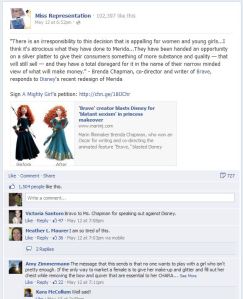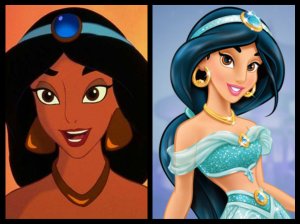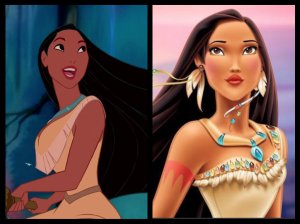(Ack! Okay, I swear I was working on writing this before the post two below me – sorry Em! Hopefully this presents another angle on the conversation)
Like Em, I have been getting a lot of news recently via Facebook, tumblr, and a variety of other media sources I check, regarding the redesign of Merida from Brave. It’s actually kind of encouraging to see just how much support the petition and general outrage about this has shown up – there are people being critical of mainstream media representations of women! Wow!
This is one example from Facebook. Note the number of people who have engaged with this post in various ways.
The official Change.org petition has 226,807 signatures as of when I checked:
https://www.change.org/petitions/disney-say-no-to-the-merida-makeover-keep-our-hero-brave
I watched and loved Brave just as much as anyone else, and I am also very disappointed with how much Disney has sexualized this 12 year old character and taken away her awesome hair! However, I would also like to point out something that bothers me a lot regarding the internet reaction to this issue:
Disney has actually redesigned all of the princesses, of which Merida is just the latest makeover. These are four images of the new looks for the princesses of color, all of whom have been ‘beauty standardized’ in various ways, whether wearing makeup, having lighter eyes – look at Mulan’s hint of blue! – or wearing more ‘fashionable’ clothing – you can’t see it in the picture, but Pocahontas is sporting some very intense boots. But the most noticeable thing (at least for me) at first glance was the drastic skin lightening on every single one of them, definitely providing evidence that colorism is alive and well in our society today. [1] Margaret Hunter writes that “light skin color, as an indicator of beauty, can operate as a form of social capital for women” (247) – and what better way to ingrain this in our heads than lightening the skin of Disney princesses, who honestly hold enormous social capital in our media-driven world today and are supposed to be role model characters for girls?
I tried searching for a parallel petition for these princesses, like the one that was started for Merida. I could not find anything besides this one:
http://www.change.org/petitions/disney-stop-whitewashing-our-princesses-of-color
42 signatures. (The only other one I could find, which was a general “stop changing all the princesses”, had 28). 42 to 226,807. Why are so many people ignoring these princesses, and why are SO many people so angry about Merida? One very obvious difference sticks out to me: race.
This reminded me of the discussion we had a couple weeks ago in class about Kathy Davis’ observation of her colleagues’ relative discomfort with the idea of ethnically-based plastic surgery compared to breast enlargement, for example. (87) [2] I am actually unsure about the contrast between this example and what I have just written about. Why do you all think [presumably white] academics are so disturbed by Asian women getting their eyes enlarged, yet hundreds of thousands of people on the internet have overlooked princesses of color getting redesigned in favor of defending a white princess weeks later?
(My first thoughts are that it might have something to do with visual media, and being able to actually see the before and after pictures on the Internet versus Kathy Davis verbally describing the surgery as trying “to make their eyes look more Western” to her colleagues…? But I’m interested to hear what you all think.)
References
- Margaret Hunter. “The Persistent Problem of Colorism: Skin Tone, Status, and Inequality.” Sociology Compass (2007).
- Kathy Davis. Dubious Equality & Embodied Difference: Cultural Studies on Cosmetic Surgery (2003).





thescotchtapemedic
May 20, 2013 at 10:14 pm
Yeah! Writing the comment about Merida got me thinking about the treatment of the other princesses. I remember owning a Mulan doll as a child, but you could never find her in her “Ping” costume, only in her “matchmaker” finery. The way that Merida has been made over for her merchandising and marketing is the same way that Mulan was made up after the release of her movie. Disney has been quietly ‘making over’ a number of princesses, but Merida has so far been the only one to cause a sizable stir.
Is it because of Brave’s complete rejection of idealized beauty norms, or is it because Merida is a beloved white princess that there’s been such a backlash?
emilypatriciamarie
May 23, 2013 at 5:00 pm
I actually had a Mulan doll when I was young, too! But she *only* had her “Ping” outfit! Haha, maybe my doll stole your doll’s outfit? Did yours have articulated joints so that she could kick and stuff? Mine did. It was awesome. But look at this makeover! What an awful backslide.
I think part of the backlash is that Merida is the newest Disney princess, so she has garnered the most attention, but that does not completely account for the erasure of the princesses of color. Maybe for a lot of people, colorism is subconscious and they just don’t pay attention to these sorts of things. Of course, these are just theories.
But you make an apt comparison between Merida and Mulan. Both are girls who reject what they are supposed to do and how they are supposed to act because of their femininity and position in society, and both make significant, symbolic changes in their appearance/clothing in the course of their respective movies to emphasize this rejection. But both of these princesses are reduced to their pre-rejection appearances and, symbolically, their pre-rejection personas for certain marketing campaigns; thus these campaigns are advocating the objectification, commodification, and forced passivity that both these films rebel against. For example, the Merida Barbie:
http://shop.mattel.com/product/index.jsp?productId=12501518
She only has the restrictive dress that she hates! And a crown! The company tosses aside the values of Brave for the stereotype that little girls crave glamour, and thus that a “prettified” version of Merida will sell more! Blech.
victoriadan
May 23, 2013 at 9:46 pm
The way I see it, Brave did not become an instant classic in the same way that these other Disney movies did. I don’t think she is a beloved Disney “princess” on the same level as Cinderella, Pocahontas, Ariel, etc. Maybe part of it was her distinct “otherness” of Merida’s Scottish accent, since the other princesses for the most part speak fairly Standard American English (older movies like Snow White have a bit different voice acting, but basically standard).
However, I’d also like to point out that Brave was made by Pixar and distributed by Disney. From my experience with Pixar films, I don’t think the studio is much in the business of overtly selling sex. The way I interpreted the trailers and movie, Brave was not really supposed to be a Disney princess story in the traditional sense (girl with unfulfilled desires meets man of her dreams who helps/saves/enlightens her and they go on to live happily ever after). Yet it being a movie about Scottish royalty of course must have seemed like a great opportunity on the part of Disney to cash in on the princess franchise and advertise Merida in this light.
The problem is you can’t put a tomboyish, red-headed, freckled, Scottish girl in the same category as Disney princesses, who occupy a sort of paradoxical space of elegance, fierceness, docility, courage and… sexual availability. These characteristics are, I believe, the reasons why we are less shocked by the transformations of colored princesses into more white, sensual characters. We already see beauty as being a major part of their role. Perhaps Disney thought that Merida in her child form wouldn’t sell properly, or that she would undermine the other princesses (and thus the franchise) with her youthful wiliness. So they present her in a more grown-up, malleable, and “princess-like” version. That’s my take on it anyway.
tsutsuis
May 29, 2013 at 10:19 pm
The way I see it is that, in part, the general population is ignorant or unaware of the undermining messages regarding beauty and race that come along with one altering the appearances of the Disney princesses. Had I not taken this course I probably wouldn’t have thought about colorism, Western influences, or beauty standards when looking at the changes. In other words, I probably would have been like, “Oh, the princesses look so mature and womanly now” or “Wow she looks so much more defined or more realistic.” I wouldn’t have looked at them an said, “The lightening of her skin and her increased eye size reflect a desire to be white.” In a way, they lack that lens of beauty and racial politics.
Furthermore, I feel like it is hard for people to relate to these princesses since they are animate and, well, fictional characters. Although I may share similar life problems and experiences, I find it difficult to relate my looks with non-living, animated characters since they are so different from how an actual person may look. Contrastingly, it is difficult for one to fathom why a woman would undergo plastic surgery since we can in ways relate to one another. For me, it’s hard to pinpoint what it is about cosmetic surgery that makes me cringe. When I think about it more I feel that is has something to do with cosmetic surgery being so artificial and fake. You’re literally altering the way your body is. I guess it’s just hard for me to accept that some women feel the urge or need to get cosmetic surgery. Due to this relationship we all share as women (being alive and being human) it becomes difficult to accept such alterations.